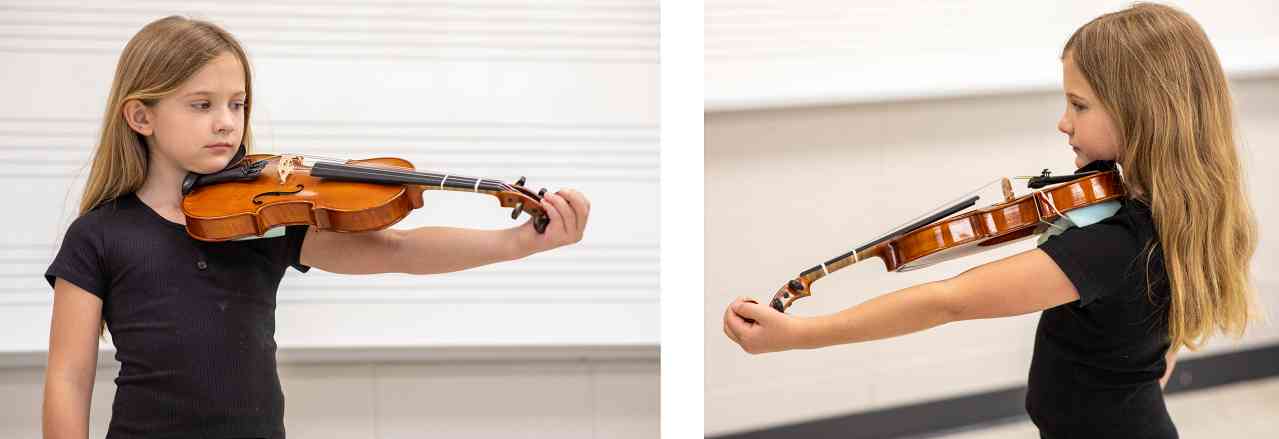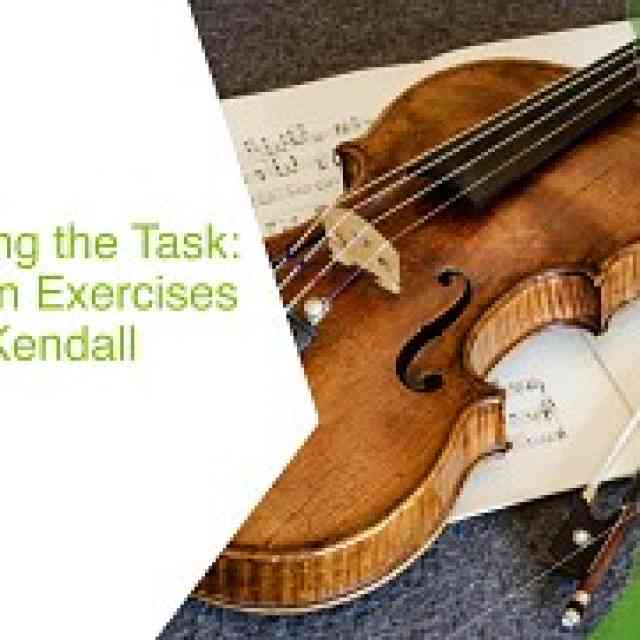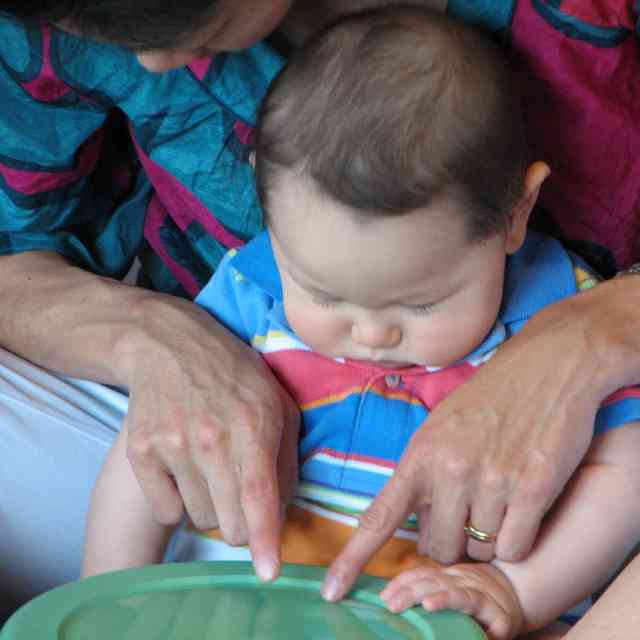A pair of Nikes two sizes too large won’t make your basketball-playing daughter jump higher. In fact, they’ll make her trip and fall even more! The same is true of violin size: a larger instrument won’t make her play better or learn faster, it will only lead to discomfort and frustration. All too often, however, I find students (and parents) fixated on moving to the next larger violin size before the student’s body has grown enough. Untangling this web of competing desires—from parents seeking an external symbol of their child’s learning to a student’s desire to grow up—requires an intricate dance from the teacher. But luckily, there is a way forward. Through clear and consistent communication, accurate metrics, and a little bit of patience, everyone will be on board with finding the correct violin size to enable the student’s continued development.
Violin Size Overview
Violin sizes are measured in fractions of a full-sized instrument. They begin at 1/64 and continue in increments: 1/32, 1/16, 1/10, 1/8, 1/4, 1/2, 3/4, 7/8, and 4/4 (full-sized). Many teachers use the term “fractional-size violins” when they refer to violins smaller than full-sized. As the child grows, they will switch to the next larger-sized instrument. Because of the unpredictable growth rates of children, students should rent instead of purchase in the early stages of violin learning. Whether children are short or tall, three years old or thirteen years old, there will always be a violin that fits their size.
For the smallest beginning students, many teachers will start them with a box violin. Box violins are easily made with a small box—a macaroni and cheese box works well—a paint-stirring stick, a rubber band, materials for decoration, and tape. You can also buy pre-made “pre-violins” online. Box violins weigh next to nothing, so it is easy for a young child to handle. Also, since these instruments do not actually make a sound, they do not distract the child from learning the basic violin posture and bowing rhythms before transitioning to a real violin.
Misconceptions
Sometimes, parents and students mistakenly think that moving to a larger violin size is itself some type of accomplishment and a manifestation of the student’s successful development of violin technique. Some of this misconception stems from believing that upsize is the same as upgrade—as in “upgrading” to a “better” instrument. Parents and students also fall victim to comparison, and when they see other students who have moved up a size, they wonder if they need to do the same. It is important to remember and communicate that going up a size only has to do with the physical size of a child. There will be a point where the child has simply outgrown their current violin. The teacher will be able to judge that. A student cannot skip ahead on violin sizing just because they want a better-sounding violin. I should add that if a teacher does not think a child is physically ready for the next larger size, the teacher is not holding the child back; the teacher is merely being responsible and caring for the child’s physical welfare.
Another misconception is that violin sizing works like children’s clothing. Oftentimes, family and friends buy clothing that is bigger than a child’s current size because it will last longer. It may be tempting for parents also to want a larger-sized violin, thinking, “My child will grow into it.” But fitting a child for a violin is not the same as fitting a child for clothing. It is not only frustrating for the child to be playing a large, unwieldy instrument, but also potentially harmful physically.
Brenda Brenner, Professor of Music Education at Indiana University, stresses in her lectures and pedagogy classes: “It is always better to err on the side of too small rather than too large.” Students might experience slight annoyance with a smaller violin because they feel cramped, but it will not injure them. When we play the violin, we are already asking our body to do something that is not necessarily natural. It is extremely important that we are mindful of how we can keep our students physically healthy from the start of their violin journey.
Why Err on the Side of Too Small?
Having a violin that is too big can throw the entire body out of alignment. Here are a few of the risks that a child can encounter with a violin that is too large:
-
Alignment issues from having to arch the body to play a violin that is too large.
-
Tendonitis or tension from constant strain in the left arm, wrist, and fingers: a large violin forces finger placement to be unnaturally far apart, and the larger violin neck may be too thick for the child to handle.
-
Tendonitis or tension from constant strain in the right (bow) hand: stemming from holding a bow that is too heavy or large.
-
Upper body strain from extra weight: the extra weight of a violin that is too large can strain a child’s jaw, neck, shoulder, and arms. Extra weight can also cause the violin to “sag,” making it unbalanced and making the bow lose a good contact point with the strings.
-
Physical discomfort in producing good sound: students will have to choose between pushing their arm uncomfortably forward to make a straight bow, or having a crooked bow. The latter affects good sound production.
-
Increased difficulty learning proper techniques: this can result in ongoing inappropriate or harmful habits as the child’s playing matures.
-
Loss of interest and motivation: the frustration of playing an instrument that is too big can cause a student to quit or lose interest and motivation out of frustration.
How Students Can End Up with a Violin That Is Too Large (Caution!)
Grandparents and parents sometimes become excited and buy a new violin for a special event: Christmas, a birthday, or any other celebration that encourages a present. However, they may end up buying the wrong-sized violin, or one of poor quality. If this happens to your family, I recommend that you ask for a return or exchange on the instrument.
Often, violin-sizing decisions can end up being tied to a contract or agreement, real or imagined, that parents have with the music store. This is usually the scenario: the contract is about to expire and the store contacts the parents for an upgrade. Parents who are unsure about the importance of violin sizing think: “Why not? Let’s do it. It’s always nice to change things up a bit to keep learning interesting.”
Sometimes violin sizing is tied up with the convenience of a “quick trip to the store.” For example, a few of our students rent violins from a store in Nashville, the nearest big city to our town of Bowling Green, Kentucky. Sometimes when parents go shopping in Nashville, they just swing by and get a bigger instrument when their current contract needs renewing. Nashville is about a seventy-minute drive from Bowling Green, so it’s just far enough that when they make a trip out there, parents like the idea of multi-tasking. They also think it is convenient to go ahead and get it done, so that they do not have to make the drive at a later date. Unfortunately, sometimes we are put in the uncomfortable situation of needing the parents to return the instrument before the next violin lesson.
Occasionally, the staff working at a music store can have a different opinion of what I think is a good violin size or fit for my students. The staff may or may not be string players. Sometimes, they are high-school musicians or undergraduates at the nearby university. Neither category tends to be familiar with the intricacies of violin sizing. Additionally, some shops charge higher rental rates for larger-sized instruments, which creates a financial incentive for them to push students to the next size prematurely.
I have unfortunately found that on occasion, some teachers who work in larger ensembles are tempted to use bigger instruments in order to achieve a richer and fuller sound in the ensemble quickly. But the benefits of such a move are short-lived, and the consequences can be long-term.
Perhaps the hardest scenario to deal with is a pleading child. “But Mom, why can’t I play the full-sized violin that Grandpa got me for Christmas?” or “Please, Dad, my friends at school sound better with a bigger violin!” If you are lucky, conversations like these will not occur in the course of your child shuffling through several fractional-size violins. But if the conversations come up, parents need to stay firm and be the voice of reason. They should ask their teacher for help in explaining sizing in a way that will be digestible for a seven-, nine-, or twelve-year-old. Again, open and frequent communication between teacher and parents is paramount.
The Right Size Violin for a Child
The crux of the issue lies in determining the correct size violin for the child, and the teacher’s ability to explain and demonstrate this effectively. The most common sizing method is based on the child’s arm length, but this only takes into account one aspect of their body. Instead, I use three metrics to size students: 1) length of the arm; 2) shoulder width; and 3) finger spacing. Triangulating these three reference points provides a more circumspect evaluation of a student’s body and better accounts for variations in individual physical size. For example, a student with long arms but slight shoulders will have a difficult time supporting a larger and heavier violin, even though their arm comfortably reaches around the scroll. Each teacher needs to appropriately weigh the importance of these three measurements for the individual student.

Figures 1 and 2. An appropriately sized violin. The student can comfortably curve their left hand around the scroll while maintaining a bend in the elbow.

Figures 3 and 4. The violin is too large. The student cannot wrap her fingers around the scroll. Notice the hyperextended elbow in the view from the G-string side of the violin.
To size a student based on their arm length, comfortably curve their left hand around the scroll when the instrument is placed in the playing position. The left arm should not be completely stretched out, but rather slightly bent at the elbow (figs. 1 and 2). If the fingertips do not reach the end of the scroll (inside the pegbox), or if the arm is hyper-extended (figs. 3 and 4), a smaller size is needed. There are charts that use the measurements of a child’s arm length to determine the size of the violin. I do not recommend this method, as students should be measured in person.
The next metric is the student’s shoulder width. The lower left corner of the violin should not extend beyond the end of the student’s left shoulder. This metric accounts for the weight of the violin: if a greater portion of the instrument’s mass is hanging beyond the student’s body, the instrument will feel heavier and droop down, leading to multiple setup issues (figs. 5 and 6).

Figure 5. The corner of the violin aligns with the end of the student’s shoulder, as indicated by the pencil.

Figure 6. This violin is too large for the student. The corner of the violin extends well beyond the end of the student’s shoulder.
My third metric is based on a student’s finger spacing. Ensure that the student can comfortably place all four fingers in first position (the span of a perfect fourth from first to fourth fingers). While proper arm position and balance can alleviate the need to stretch for certain notes, neither of these techniques can overcome a string length that is simply too large for a student’s hand.

Figure 7. The student’s elbow easily makes a 90-degree angle when placing the bow at the middle point.
In addition to these three metrics, it’s worthwhile to consider the relationship between the bow and the violin. A larger violin moves the contact point further away from the student’s body, requiring a proportional change in the right arm. Check that when the bow is placed on the strings at its middle point, the right elbow creates a 90-degree angle (fig. 7). If the angle is greater than 90 degrees, the instrument is too large.
These metrics provide multiple angles from which teachers can evaluate violin size. Keep in mind that a student rarely fits each metric perfectly. In fact, the student in the photos here illustrates this point. Her arms and head appear to necessitate a larger violin, yet her shoulder width and finger spacing require a smaller size. Teachers must balance the relative weight of each metric to determine the most appropriate size for each student.
How to Help Small Violins Sound Better
I understand that at the beginning stages, parents might think, “Should I invest the extra money in renting from a string-specific store instead of just going to a general music store? The rental fee is twice the amount per month at the string-specific store.” My answer is: “Absolutely go to the string store.” In order for a child to fall in love with the sound of the violin, you want to give them the best tools you can find. If you do not have the finest quality you can get your hands on, you are already starting from a deficit.
After they have the finest quality instrument, make sure they take care of it. Below are several tips for maintaining an instrument.
-
Change the strings. The average lifespan of strings is 250 to 300 playing hours. This means to change strings at a minimum of once a year. If the child practices more than an hour a day, change the strings at least every six months. Most rental companies will change the strings for you once a year as a part of their maintenance fee, but you can also purchase additional strings if you want to change them more often.
-
Clean the violin after every use. It is important to keep rosin off the strings and the varnish by using a cloth. When the rosin is not wiped off, it can dampen the violin sound and eventually damage the varnish. Microfiber cloths (similar to eyeglass cleaning cloths) work well because they are gentle, do not scratch surfaces, and are lint free.
-
Bow hair maintenance. Make sure that the bow has a full stick of hair and that it is not worn, “black,” or “gross” at the frog. Throughout the course of a student’s practice sessions, some hair will fall out or break. Inevitably, some natural oils from the hands will also get on the hair, especially at the frog. Re-hairing the bow when buildup happens, or the hair thins, will solve this problem. Most violin shops will do one to two re-hairs per year on your rental instrument.
-
Purchase high-quality rosin. This helps to produce the best sound. A good bow, well maintained and well rosined, will make any violin sound better so remember to rosin your bow.
-
Patience! Last but not least, be patient. Children grow up in the blink of an eye. If they continue to work to produce the best possible sound from the smaller-sized violins, they will be even more equipped at drawing a beautiful tone from the next size of violin.
What to Do When Moving Up in Size
When the time comes for a student to move to a larger violin, take time in the lesson to go over the differences and highlight the physical changes that will need to take place. A good time to do this is while you are placing new finger tapes or double-checking their measurements. Re-emphasize the importance of healthy, tension-free playing, and remind students and parents to space out practice accordingly. Just because the instrument is larger doesn’t mean that you have to suddenly start using more muscles!
A move to a larger instrument offers a perfect opportunity to reinforce the concept of review. When one of my students upsizes, their practice assignment for that week is to “teach” their new violin all of their old pieces, around one book or so of pieces. I usually tell them that the violin needs to “hear” each piece five times to truly learn it. Through this process, the student’s ears and physical setup become accustomed to the new instrument by using pieces that they already know.
Trust the Teacher
Clear and consistent communication throughout all sides of the Suzuki triangle can prevent violin sizing from becoming a sensitive topic between parents and teachers. If it has reached that stage, I suspect that it is a matter of miscommunication or misunderstanding. To be honest, I have struggled with unnecessary conflict a few times on this issue, so now I have, thankfully, become more sensitive and equipped in addressing the topic with parents. Violin sizing should never become a power struggle. Our goal is to help the child succeed with the right-sized violin. Everyone will be happier.
In my own teaching, violin sizing is a topic I discuss head-on, starting with our New Parents’ Meeting. I also talk about the pros and cons of having the right violin size whenever it makes sense to fit it into a lesson. I have also learned to make a point of addressing it before winter break to prevent Santa from delivering a “new, bigger, and better” violin to the child during the holiday season. Children often experience a growth spurt during the summer, so keep a close eye on the instrument situation throughout the summer. I encourage parents not to make any hasty decisions without my input, especially if the child is traveling for parts of the summer or if we are unable to have regular in-person lessons because I am teaching at another summer festival. I remind them that continuing to play the current violin will not harm the child, and that I want to be there for the transition to a bigger violin.
Fortunately, I find that, after we have covered all the seasons of the year and hit all major celebrations throughout the year, parents will understand: yes, this is an important topic! It truly is.









